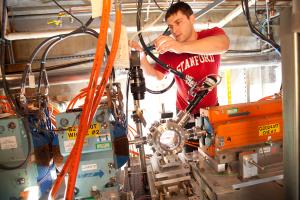ESP Biography
SPENCER GESSNER, 3rd year grad student in physics
|
Major: Physics College/Employer: Stanford Year of Graduation: G |

|
Brief Biographical Sketch:
I am a life-long physicist. I began doing physics research in high school at IBM's T.J. Watson Research Center in Yorktown, NY. As a physics major at UCSB, I worked on the CMS experiment which is now operating at the LHC. While at UCSB, I worked for the university tutoring service, teaching math and physics to undergraduates. I also volunteered with the School for Scientific Thought which was an outreach program for area high school students. I now work at SLAC National Accelerator Laboratory. We study Plasma Wakefield Acceleration, an advanced acceleration method to produce high energy particles. Past Classes(Clicking a class title will bring you to the course's section of the corresponding course catalog)P3239: Muon in a Jar in Splash! Fall 2013 (Nov. 02 - 03, 2013)
In this class we build a particle detector using stuff you can find around your house. Our particle detectors can see subatomic particles called muons coming from outer space!
P2908: Muon in a Jar in Splash! Spring 2013 (Apr. 13 - 14, 2013)
In this class, we build cloud chambers to detect muons! From space!
P2384: Muon in a Jar in Splash! Fall 2012 (Nov. 03 - 04, 2012)
We build cloud chambers to detect muons produced by cosmic rays from outer space.
P2044: Muon in a Jar in Splash! Spring 2012 (Apr. 21 - 22, 2012)
In this class we will build Particle Detectors using items you can find around the house. Our homemade detectors will see muons created by Cosmic Rays coming from outer space!
P2329: High Energy Physics: Particles, Accelerators, and Detectors! in Splash! Spring 2012 (Apr. 21 - 22, 2012)
It's been an exciting year for particle physics-- last December scientists announced they might have seen the first hints of the Higgs Boson, a never before seen particle!
But why does the Higgs Boson matter? And how can we see it? In this class, we'll explore every step of how scientists look for the fundamental building blocks of matter-- from accelerating particles, to explaining the theories, to looking at the data.
Note that this class will have an hour lunch break in the middle, and continue afterwards-- when we'll take a field trip to the SLAC National Accelerator Laboratory a few miles away. We'll see a real accelerator and visit the control room, and even visit one of SLAC's gargantuan particle detectors.
P1652: Muon in a Jar in Splash! Fall 2011 (Oct. 29 - 30, 2011)
In this class we will build particle detectors. Really? Really. They will detect cosmic rays from space using stuff you can mostly find around the house. If you had done this sixty years ago you would have won like 5 Nobel Prizes.
P1309: Muon in a Jar (Particle Physics on Your Table) in Splash! Spring 2011 (Apr. 16 - 17, 2011)
Ouch! Did you feel that? Muons produced by high energy cosmic ray collisions in the atmosphere are passing through us all the time!
In this class, you will have the opportunity to actually see these muons with a particle detector that you will build, using parts you can find in your own house!
S1103: The Particle Zoo in Splash! Fall 2010 (Nov. 13 - 14, 2010)
This course will be an overview of the many sub-atomic particles and there infinite combinations. Starting from the discovery of the electron, this course will give a historical qualitative description of the many particles that we know exist. This course will be very light on mathematics, but topics such as decay time and relativity will be discussed. The main thrust of this course will be to give the students a very general overview of the sub-atomic world, and develop a "period table" of particles in analogy to the periodic table of elements.
S1104: The Physics of Phootball in Splash! Fall 2010 (Nov. 13 - 14, 2010)
We will look at the sport of football through the lens of Newtonian mechanics. We will use videos of Stanford Cardinal football games to look at the flight path of thrown and kicked balls, and the physics of tackles. Projectile motion and collisions will be emphasized.
This class will be interactive, with some time spent outside running around. I will put heavy emphasis on what constitutes safe play and how physics can instruct us on ways to avoid injuries.
|
|
